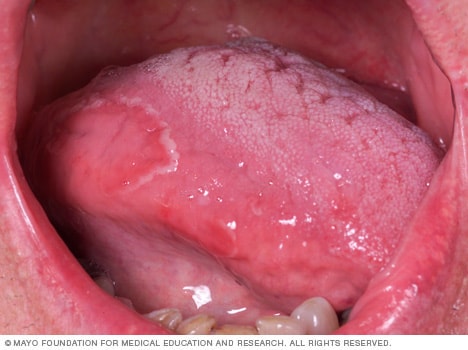Overview
Geographic tongue

Geographic tongue
Geographic tongue results from the loss of tiny hairlike structures on your tongue's surface. These structures are called papillae. The loss of these papillae appears as smooth, red patches of different shapes and sizes.
Geographic tongue is an inflammatory but harmless condition affecting the surface of the tongue. The tongue usually is covered with tiny, pinkish-white bumps called papillae. These papillae are actually fine, hairlike structures. With geographic tongue, patches on the surface of the tongue are missing papillae. These patches are smooth and red, often with slightly raised borders.
This condition is called geographic tongue because the patches make your tongue look like a map. The patches often appear in one area and then move to a different part of the tongue.
Although geographic tongue may look alarming, it does not cause health issues. It's not related to infection or cancer. Geographic tongue sometimes can cause tongue pain and make you more sensitive to certain foods, such as spices, salt and even sweets.
Products & Services
Symptoms
Symptoms of geographic tongue may include:
- Smooth, red, irregularly shaped patches on the top or side of your tongue. These patches may look like sores.
- Frequent changes in the location, size and shape of the patches.
- Pain or burning feeling in some cases, most often related to eating spicy or acidic foods.
Many people with geographic tongue have no symptoms.
Geographic tongue can continue for days, months or years. The problem often goes away on its own, but it may appear again later.
When to see a doctor
Because most people with geographic tongue don't show symptoms, they won't need treatment. If you have symptoms, they may be related to a fungal infection, so see your doctor or dentist. In some cases, medicine may be prescribed to help ease symptoms.
Causes
The cause of geographic tongue is not known, and there's no way to prevent it. There may be a link between geographic tongue and other conditions, such as psoriasis. This is a skin disease that causes a rash with itchy, scaly patches. But more research is needed to learn about possible connections to other health conditions.
Risk factors
Factors that may increase your risk of geographic tongue include:
- Family history. Some people with geographic tongue have a family history of it. So genetic factors may raise the risk.
- Fissured tongue. People with geographic tongue often have a condition called fissured tongue. This is when deep grooves, called fissures, appear on the surface of the tongue.
Complications
Geographic tongue is harmless, but it can sometimes be uncomfortable. It does not pose a threat to your health, cause long-term complications or raise your risk of major health problems.
This condition can cause anxiety. That's because the appearance of the tongue may be embarrassing, depending on how well the patches can be seen. It also may be hard to believe that nothing is seriously wrong.
Sept. 07, 2023